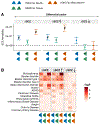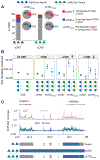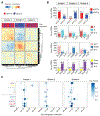Chromatin domain alterations linked to 3D genome organization in a large cohort of schizophrenia and bipolar disorder brains
- PMID: 35332326
- PMCID: PMC8989650
- DOI: 10.1038/s41593-022-01032-6
Chromatin domain alterations linked to 3D genome organization in a large cohort of schizophrenia and bipolar disorder brains
Abstract
Chromosomal organization, scaling from the 147-base pair (bp) nucleosome to megabase-ranging domains encompassing multiple transcriptional units, including heritability loci for psychiatric traits, remains largely unexplored in the human brain. In this study, we constructed promoter- and enhancer-enriched nucleosomal histone modification landscapes for adult prefrontal cortex from H3-lysine 27 acetylation and H3-lysine 4 trimethylation profiles, generated from 388 controls and 351 individuals diagnosed with schizophrenia (SCZ) or bipolar disorder (BD) (n = 739). We mapped thousands of cis-regulatory domains (CRDs), revealing fine-grained, 104-106-bp chromosomal organization, firmly integrated into Hi-C topologically associating domain stratification by open/repressive chromosomal environments and nuclear topography. Large clusters of hyper-acetylated CRDs were enriched for SCZ heritability, with prominent representation of regulatory sequences governing fetal development and glutamatergic neuron signaling. Therefore, SCZ and BD brains show coordinated dysregulation of risk-associated regulatory sequences assembled into kilobase- to megabase-scaling chromosomal domains.
© 2022. The Author(s), under exclusive licence to Springer Nature America, Inc.
Conflict of interest statement
Competing Interests Statement
The authors declare no competing financial interests.
Figures






References
References (Methods)
Publication types
MeSH terms
Substances
Grants and funding
- R01 MH094714/MH/NIMH NIH HHS/United States
- R21 MH103877/MH/NIMH NIH HHS/United States
- U01 MH103365/MH/NIMH NIH HHS/United States
- U01 MH103392/MH/NIMH NIH HHS/United States
- DP1 MH129957/MH/NIMH NIH HHS/United States
- U01 MH103346/MH/NIMH NIH HHS/United States
- U01 MH103340/MH/NIMH NIH HHS/United States
- U01 DA048279/DA/NIDA NIH HHS/United States
- P50 MH096890/MH/NIMH NIH HHS/United States
- R21 MH105881/MH/NIMH NIH HHS/United States
- R01 NS114226/NS/NINDS NIH HHS/United States
- P50 MH106934/MH/NIMH NIH HHS/United States
- R01 MH105472/MH/NIMH NIH HHS/United States
- R01 MH106056/MH/NIMH NIH HHS/United States
- U01 MH103339/MH/NIMH NIH HHS/United States
- ZIC MH002903/ImNIH/Intramural NIH HHS/United States
- R21 MH102791/MH/NIMH NIH HHS/United States
- R01 MH105898/MH/NIMH NIH HHS/United States
LinkOut - more resources
Full Text Sources
Other Literature Sources
Medical

